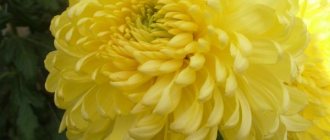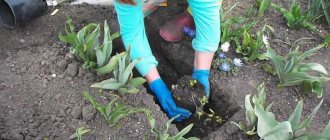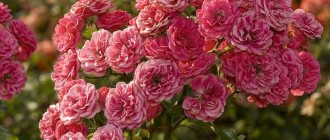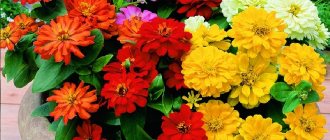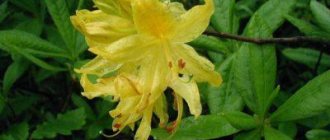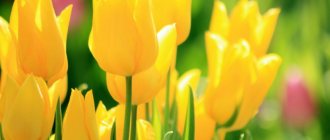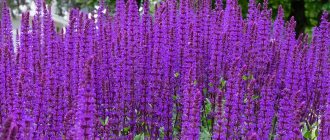Home » Garden and vegetable garden » Garden » Berry bushes
Olga Polyakova 03/17/2020
10702 Views 1 comment
Dogwood
Dogwood is a deciduous perennial plant with a spreading crown. There are both woody and shrubby forms of this plant. The family to which it belongs has the same name - Dogwood.
All its representatives are characterized by the same flower shape, although plants can differ significantly. Dogwood is native to the tropics of China, where it has been cultivated for a very long time, thanks to the unique taste of its berries, which are capable of self-fermentation.
It is possible that humanity obtained its first alcoholic drinks from dogwood. Another feature of that plant was its unique wood, which has exceptional strength.
Even the strength of the legendary ebony tree - persimmon - cannot be compared with the strength of dogwood wood fibers. Caring for dogwood is relatively simple, but its propagation and planting can puzzle a novice gardener, because getting the seeds of this plant to “wake up” requires a lot of work.
Dogwood berries
Crimean legend, dogwood, devil's berry, red doctor - whatever people call the dogwood bush. According to legend, dogwood branches sprouted from a spear that the founder of Rome, Romulus, stuck on the hill where the ancient capital of the Roman Empire subsequently arose.
Over time, this plant became so widespread in the area that the Romans began to actively use it in everyday life - they made healing, strengthening decoctions from dogwood leaves and fruits, and used the branches to make sword handles.
Dogwood is one of the first trees to bloom in early spring
This plant was nicknamed the devil's berry because of its deceptive precocity: the dogwood bush is one of the first to bloom, but the berries themselves, although they turn red very early, become suitable for consumption only in the fall.
Sometimes such a plant is called “dogwood” - this corresponds to the literal translation from the Turkish and Chagatai languages (“dogwood” - literally “red”). Despite such an abundance of nicknames, only two remain traditional synonyms for this berry: “turf” and “dogwood”.
Externally, the fruits of the doren resemble a small red pear: they are dense in structure, fleshy, have a strong skin and an inedible seed. Color can vary from orange to dark purple. The average weight of one berry is 4 grams, of which about 80% is juicy pulp.
The taste of dogwood fruits is tart and astringent
Dogwood is one of the most ancient plants on earth - dogwood seeds were discovered during excavations of Neolithic settlements, the age of which is estimated at 5 thousand years.
general description
The dogwood bush got its name from the Turkic word “kyzyl”, which means “red”. Most often, the culture is found in the Crimea, in the vast Caucasus, in Southwestern Europe and East Asia. It is a low tree or large shrub with diametrical, oval leaves.
It begins to bloom in April, harvesting can begin in August and until the end of September. The berries are oval with a large seed inside, dark red in color, with a rich tart-sour taste. The plant is unpretentious in its qualities, tolerates temperature changes calmly, and does not require special soil or abundant watering. When growing and caring for shrubs, great attention must be paid to pruning the plant in order to add decorativeness and increase productivity.
Chemical composition
Derain berries are a low-calorie product: 100 grams contain only 45 kcal. The ratio of BJU is 1:0:9 - this allows you to include dogwood in the diet. So, compote from this berry contains about 25 kcal, and the energy value of jam is 170 kcal per 100 grams.
The chemical composition of dogwood includes:
- alimentary fiber;
- ash;
- vitamins C, PP;
- potassium;
- magnesium;
- calcium;
- phosphorus;
- iron;
- sodium;
- sulfur;
- selenium;
- zinc;
- pectins;
- Apple acid;
- disaccharides.
Nutritional value of 100 g of dogwood
Dogwood leaves also contain a huge amount of tannins - tannins that extract protein from food and fix it in the body. In addition, dogwood leaves are rich in fructose, arabinogalactan and rutin.
Dogwood flowers contain gallic acid and isoquercitrin, powerful antioxidant substances. Such a rich chemical composition determines that almost all parts of this plant are used in folk medicine and cosmetology - from roots to flowers.
How to shape
Dogwood can be formed in the form of a bush with a trunk 30-50 cm high and 5-7 skeletal branches. Systematically remove root growth.
For fruit-bearing trees in early spring, regularly carry out sanitary pruning: remove dead and broken shoots, thin out, cutting out intertwined and densely located branches, striving for good illumination of the center of the crown. If you are late with pruning, juice will flow out of the wounds.
Useful properties of dogwood
This “red doctor” is truly a folk healer - he has a lot of useful properties and effects:
- normalization of blood pressure;
- prevention of atherosclerosis;
- elimination of diseases of the gastrointestinal tract, normalization of stool, increased activity of the pancreas;
- acceleration of metabolism;
- antipyretic effect;
- removal of uric acid and toxic substances;
- strengthening the walls of blood vessels, veins, reducing swelling of the legs and preventing venous insufficiency;
- eliminating oral infections, relieving toothache and gum inflammation;
- invigorating and tonic effect;
- decreased blood sugar levels;
- healing of purulent wounds;
- normalization of potency;
- increased concentration, improved memory and attention.
Video: beneficial properties of dogwood
For pregnant and lactating women, dogwood is also a very useful product - it not only replenishes the vitamin balance in the body, but also reduces fatigue, prevents the development of various infections and viruses, saturates the mother’s blood with iron, which prevents the occurrence of anemia, and also normalizes the processes of digestion and bowel movements .
Decoctions of this berry are even given to infants (starting from the age of 3 months): this helps relieve the baby from colic and stomach upsets, strengthens his immunity and stimulates brain activity. Dogwood also affects the development and strengthening of bone tissue, which is an important factor at the growth stage of a small organism.
Important! To obtain maximum benefits, you must adhere to the correct dosage of dogwood consumption - doctors recommend consuming no more than 150 grams of fresh berries per day, and no more than 250 grams of decoction or compote. Pregnant women are also advised to consult a doctor when including this berry in their daily diet - this will eliminate the likelihood of diseases associated with individual intolerance to this product.
Cotoneaster - ornamental shrub
Barberry bush - types, varieties, planting and care
Cotoneaster is an evergreen shrub that decorates the garden all year round; in spring and summer it pleases with delicate and bright flowers, and in autumn with red fruits.
Origin and appearance
Cotoneaster is vaguely similar to quince, which is why it was given the name Cotoneaster (meaning "quince-like"). The family includes more than a hundred different varieties of cotoneaster. They are found in the wild throughout Africa and Europe. Many summer residents, confusing it with dogwood, purchase a shrub and expect a tasty harvest of fruits with skin that begins to shine beautifully after full ripening.
cotoneaster
Irga can reach a height of 3-6 meters. The shoots, woody, acquire a blackish bark tone. The leaves are bright green, oval in shape and slightly shiny.
The flowers are small and collected in small inflorescences of 15-20 flowers, sometimes 25. The shrub begins to bloom before foliage appears on the shoots.
Decorative properties
Cotoneaster (irga) is a creeping shrub. It has proven itself well as a plant that can be used for landscaping cities and summer cottages. It is often used for planting rock garden compositions or single plantings (as a ground cover plant).
The main decorative element of serviceberry is its red fruits, which do not fall from the shoots for a long time. Another advantage is the leaves, as they are green throughout the year. Thanks to its fruits and leaves, cotoneaster looks decorative all year round.
Types and varieties
Cotoneaster has a large number of species, some of them are deciduous, others are evergreen. Each of them has its own unique beauty.
Cotoneaster fruits
Ordinary
Beautiful deciduous species, capable of reaching up to 2 m in height. Its leaves are ovate and bright green. The flowers are inconspicuous, pale pink, collected in inflorescences. The fruits resemble small red apples that fall at the end of September.
Pinned down
Not a very tall plant, grows only up to 30 cm in height. The leaves are small, in summer they have a green tint, and by autumn they turn purple. The flowers are small, have a pink tone, they sit 1-2 along the entire shoot. After ripening, the fruits become bright red and small in size, only 5-7 mm.
Cotoneaster propagation
Possible harm and contraindications
Like any other product, dogwood can have a negative effect on the body - if the daily dosage of consumption is exceeded or if there is an individual intolerance to this berry.
Eating dogwood can be harmful, especially if you have constipation, gastritis, or insomnia.
The fixative and diuretic effect of the product can be harmful to people with diseases of the genitourinary system, and increased stomach acidity can impair the digestion of this product and lead to pain in the intestines and stool disorders.
People with nervous disorders, as well as those suffering from increased nervous excitability, should limit their consumption of dogwood - it has an invigorating effect and can aggravate existing problems.
How to propagate
Dogwood is propagated:
- seeds;
- basal offspring;
- layering;
- cuttings and grafting.
When propagated by seeds, all economically valuable characteristics of the mother plant are not transmitted to the offspring; this can only be ensured through vegetative propagation. Plants obtained from seed propagation begin to bear fruit in the 5th-6th year, those grown from vegetative propagation - in the 2nd-3rd year. From dogwood seeds, seedlings and rootstocks are grown for grafting.
All methods of vegetative propagation of dogwood are quite effective.
When rooting green cuttings in a greenhouse, good results can be achieved if you turn on the fogging unit.
When propagating by horizontal layering in the spring, young branches placed closer to the soil surface must be bent and laid in pre-dug grooves 15-20 cm deep. Secure the laid branch with wooden or metal pins, and bring the top to the surface and tie it vertically to a peg. To speed up root formation, cut the bark under each leaf node. Fill the furrow with fertile soil and water it. During the growing season, regularly moisten, weed and feed the cuttings. Then separate them from the mother bush and plant them in the garden.
A more common method of dogwood propagation is budding , which is carried out on 1-2-year-old seedlings of cultivated or wild dogwood. The best time is the third ten days of July - early August. It is better to oculate with two eyes.
Collection and procurement of raw materials
In order to prepare a rich, healthy and healing decoction from dogwood, you need to know the rules for collecting and preparing this medicinal plant - when to pick and dry the leaves, when the berries ripen and how to preserve the maximum of vitamins and nutrients in the plant.
Collection
You should start collecting dogwood fruits no earlier than the end of August–beginning of September: it is by this time that the berries ripen and accumulate vitamin substances. The berries are picked only in dry weather - wet fruits will begin to rot very quickly.
You can also collect fallen berries, first shaking them off from adhering dust or dirt. It is advisable to collect all the dogwood before the beginning of October: if you leave the harvest on the bush, the fruits will become covered with rot and birds will begin to peck at them and insects will eat them.
Overripe fruits are very juicy and have a thin skin, so they are difficult to transport and difficult to dry and heat treat.
Ripe dogwood has a dark red color
The leaves are collected and dried before yellowing begins: they are usually picked during berry picking, but the leaves can be prepared earlier. If you pick the leaves before picking the berries, the bush will get rid of additional moisture consumers, and the berries will begin to receive the maximum amount of nutrients.
In autumn, dogwood leaves take on a burgundy hue; it is important to collect them while they are still green.
Flowers are collected during the flowering of the bush (early March–April) - it is important to leave a sufficient number of flowers for pollination and further fruiting of the dogwood.
Flowers should be collected before the ovary forms
The roots are dug up and dried after harvesting, before frost sets in.
The roots should be washed and chopped immediately
It is best to collect twigs in the spring: at this time they are most elastic and most suitable for household use (for example, for weaving baskets, etc.)
Dogwood has an excellent anti-scorbutic effect, which is why it has been added to the daily menu of long-distance sailors since the 19th century, and today it is also included in the diet of astronauts
.
Drying
Drying dogwood is the most optimal way to preserve the vitamins and nutrients of this plant in a concentrated form.
Harvesting berries for the winter does not require much effort or financial costs: the fruits are washed with water, they are sorted and rotten ones are removed, then they are laid out on a clean, dry surface (tablecloth, sheet, etc.) and dried in the shade.
It is important to avoid direct sunlight on the berries - they will quickly shrink and become very hard in structure.
When storing dried dogwood, important points are humidity and ventilation.
Leaves, roots and branches are dried in the same way (the flowers do not need to be washed first). Dried dogwood is poured into a linen bag and stored in a cool, dry place.
Storage
Fresh berries are stored only in a dark, cool room - dogwood is best stored at a temperature of +1-3°C. Picked fruits ripen quickly, so if you store them in a warm place, then after 5-7 days the fruits will become overripe and begin to become covered with rot. Berries picked with the stalks are best stored - this way they remain strong and firm for up to 8 weeks.
Dried leaves, roots, flowers and fruits of the tree can also be stored at room temperature - the main thing is to protect the drying from moisture. Periodically, you need to pour the dried plant into another bag or glass container - this will saturate the drying with air and prevent the workpiece from rotting or becoming damp.
You can make preserves, jams from dogwood and preserve it this way
Dried dogwood can be stored for up to 3 years under the right conditions.
Important care details
Dogwood, if you devote just a little time and effort to it, will thank the gardener with annual and abundant harvests. Care consists of watering, fertilizing and periodic pruning.
Watering
The dogwood's root system is superficial, so it can easily get by with natural precipitation. But in extreme heat and prolonged drought, watering is still needed, especially during fruit ripening. Once a week is enough. The norm for an adult plant is 30–40 liters.
A clear sign that the plant lacks moisture is the leaves curling up along the central vein.
Watering too much is practically the only way to definitely destroy a shrub. Dogwood does not tolerate stagnant moisture at the roots.
Water is poured not under the roots, but into the ring grooves or furrows between the bushes. If technically possible, it is advisable to organize drip irrigation. Sprinkling for dogwood is not a suitable option. Each time after the procedure, the soil in the tree trunk circle is loosened to a depth of 7–10 cm.
In order for the plant to properly prepare for winter, it needs moisture-recharging watering. You can refuse it if autumn is very rainy and cold. An adult bush consumes 70–80 liters of water. It is carried out approximately 2 weeks after the end of fruiting.
Fertilizer application
Dogwood survives and bears fruit without any fertilizing at all, but the application of fertilizers has a positive effect on productivity and decorativeness. The plant responds gratefully to both organic and mineral compositions.
- In spring, dogwood needs nitrogen for intensive growth of green mass. At the end of April, it is watered with a solution of urea, potassium sulfate, ammonium nitrate (15 g per 10 l).
- Once every 2–3 years, simultaneously with spring loosening of the soil, 2–3 buckets of humus or rotted manure are distributed in the tree trunk circle.
- Phosphorus and potassium are important for fruit ripening. In July and August, dogwood is watered with superphosphate and potassium sulfate diluted in water (20–25 g per 10 l). The natural source of these macroelements is wood ash, from which an infusion is prepared.
The yield of dogwood increases if it is planted in a substrate enriched with calcium. Therefore, once every 2–3 years, it is recommended to scatter dolomite flour, slaked lime, and powdered eggshells under the bush.
Dolomite flour is a natural soil deoxidizer that simultaneously enriches the soil with calcium.
Trimming
Dogwood does not need formative pruning. The only exception is landscape design, when the bush is given an unnatural fantasy configuration. The plant naturally has a crown of a regular, beautiful shape and is able to maintain it without outside help.
Dogwood bushes can be given an unusual shape, but they look quite nice without it
At the same time, do not forget about sanitary pruning. It is carried out annually, in early spring, before the buds “wake up”. In the process, they get rid of all the branches that have frozen, dried out, or broken under the weight of the snow. They also remove thin shoots that grow down and deep into the crown, are weak, twisted, and clearly violate the correct configuration.
For pruning, use only sharply sharpened and disinfected scissors, knives, and secateurs. If the cut diameter exceeds 0.5 cm, it is washed with a 2% solution of copper sulfate and covered with garden pitch.
The cutting tool must be clean and sharp.
Every 10–15 years, radical anti-aging pruning is carried out, getting rid of all branches aged 10 years and older. If there are too many of them, the procedure can be extended over 2-3 seasons. Dogwood tolerates it well, fully recovering next year.
On a grafted dogwood, be sure to remove all the growth below the rootstock. Otherwise, the bush will “go wild” again.
Video: how to prune dogwood correctly
Typical diseases and pests
Dogwood rarely suffers from diseases and pests. This applies to both natural varieties and breeding hybrids. If the summer is very cold and rainy, rust may develop.
The disease is easily identified by the bright saffron-colored fuzzy spots that appear on the underside of the leaves. Gradually they thicken and change color to copper or rusty. For prevention, dogwood is sprayed with a 1% solution of Bordeaux mixture or copper sulfate in early spring. Having discovered characteristic symptoms, use any fungicide (Skor, Horus, Kuprozan, Abiga-Pik). Usually 2-3 treatments are enough with an interval of 7-10 days.
To combat rust, as well as many other pathogenic fungi, copper-containing preparations are used
Among the pests, dogwood can occasionally be affected by scale insects. Colonies of insects on a bush can be mistaken for spilled flour. The affected parts of the plant turn yellow, dry out and fall off, the shoots become deformed, and the bush practically stops growing. For prevention, dogwoods are dusted with sifted wood ash, crushed chalk, colloidal sulfur, and tobacco chips every 12–15 days. When pests are detected, Mospilan and Confidor-Maxi are used.
Scale insects feed on plant sap
Dogwood in cosmetology
In the field of cosmetology, masks and scrubs from dogwood fruits are actively used (the bark is used only in anti-inflammatory masks). From the pulp of this plant you can prepare a natural, moisturizing and inexpensive vitamin mask for skin and hair at home, and from the seeds you can make a scrub for the face and body.
Creams and masks with dogwood extract perfectly tone and moisturize the skin, cleanse pores, eliminate oily shine, blackheads, and wrinkles. Rinsing with dogwood decoction makes hair silky and also gets rid of dandruff.
Mask for the face
A very effective remedy for fighting wrinkles is this mask:
Ingredients:
- 30 g of fresh dogwood berries;
- 30 g banana pulp;
- 10 g oatmeal;
- 10 g potato starch.
Preparation:
- Mix all ingredients well, bring to a mushy state.
- Let it brew for 3-5 minutes.
Apply this mask for 30 minutes, then rinse with warm water. It is recommended to use this product daily, in the morning or evening. The effect will appear after 5 days of using this mask.
For dry skin, it is recommended to exclude cereals and starch, but add olive oil
Dogwood is an amazing plant: it is not only actively used in folk medicine, cosmetology and cooking, but is also useful in everyday life, and is also a beautiful shrub that can decorate even the most skillful garden plot.
This “red doctor,” as people say, can cure thousands of diseases, and its rich chemical composition, as well as the enormous beneficial effect it has on the human body, fully corresponds to this opinion.
Why is it worth planting it on the site?
Gardeners are primarily attracted to dogwood fruits, which are valuable for their nutritional and medicinal properties. And if we add to this that dogwood produces high yields, is durable, drought-resistant, unpretentious, is not affected by pests and diseases, and is decorative, then it becomes clear why this plant has been revered since ancient times and grown near houses and in gardens. The dogwood plant is very decorative due to its early and abundant flowering, dense bright green foliage, and beautiful fruits. The bushes tolerate pruning well and are resistant to dust and gases. A dogwood hedge is a godsend for a gardener.
Landing
It is necessary to plant cuttings at a distance of 4-6 m. You can also plant along a fence or near other plants, retreating about 3-4 m from them. It is best to use 2-year-old seedlings, the height of which is 1-1.2 m, and the trunk diameter is about 1.5 cm. Seedlings of older age - 4-10 years - are well accepted.
Before planting dogwood, like any other agricultural plant, you should carefully prepare the soil. It is advisable to do this six months before the planned transplantation of the plant to its “permanent place of residence.” The area needs to be dug up and perennial weeds removed.
Mineral and organic fertilizers are added to the soil at the rate of 4-5 kg of organic matter per 1 m2. Green manure (peas, clover, beans, sweet clover, etc.) can act as organic fertilizers, which should be planted in spring or autumn (depending on the time of planting the dogwood), and then incorporated into the soil.
The seedling is planted in a hole 50 cm wide and 30% deeper than the root bundle (approximate depth - 40 cm). At the bottom of the pit, a mound is formed from soil and organic matter in a 1:1 ratio, and a seedling is placed on top. The roots are straightened by digging them in with earth and carefully compacting them. Then water it abundantly (3-4 standard buckets).
The root collar should be located at a level of 3-4 cm above the soil surface.
If soil preparation has not been carried out, then to plant dogwood you need to dig a hole twice as large. Its dimensions are as follows: depth - 80-90 cm, width and height - 90-100 cm. The excavated soil is mixed with organic fertilizers 1:1 and divided into two parts. A planting mound is formed from one, which should occupy half of the hole. The second part begins to dig in the roots and the plant itself. After which the plant must be watered.
If the seedling is more than 1.5 m, then it will need a support pillar, which must be dug in from the north side.
The last step is mulching. The tree trunk circle is mulched with humus 5 cm thick for spring planting, and 10 cm for autumn planting. A thin layer of soil is poured on top. In regions with severe frosts, you can additionally lay a layer of sawdust or plant debris on top to protect the young plant from freezing.

